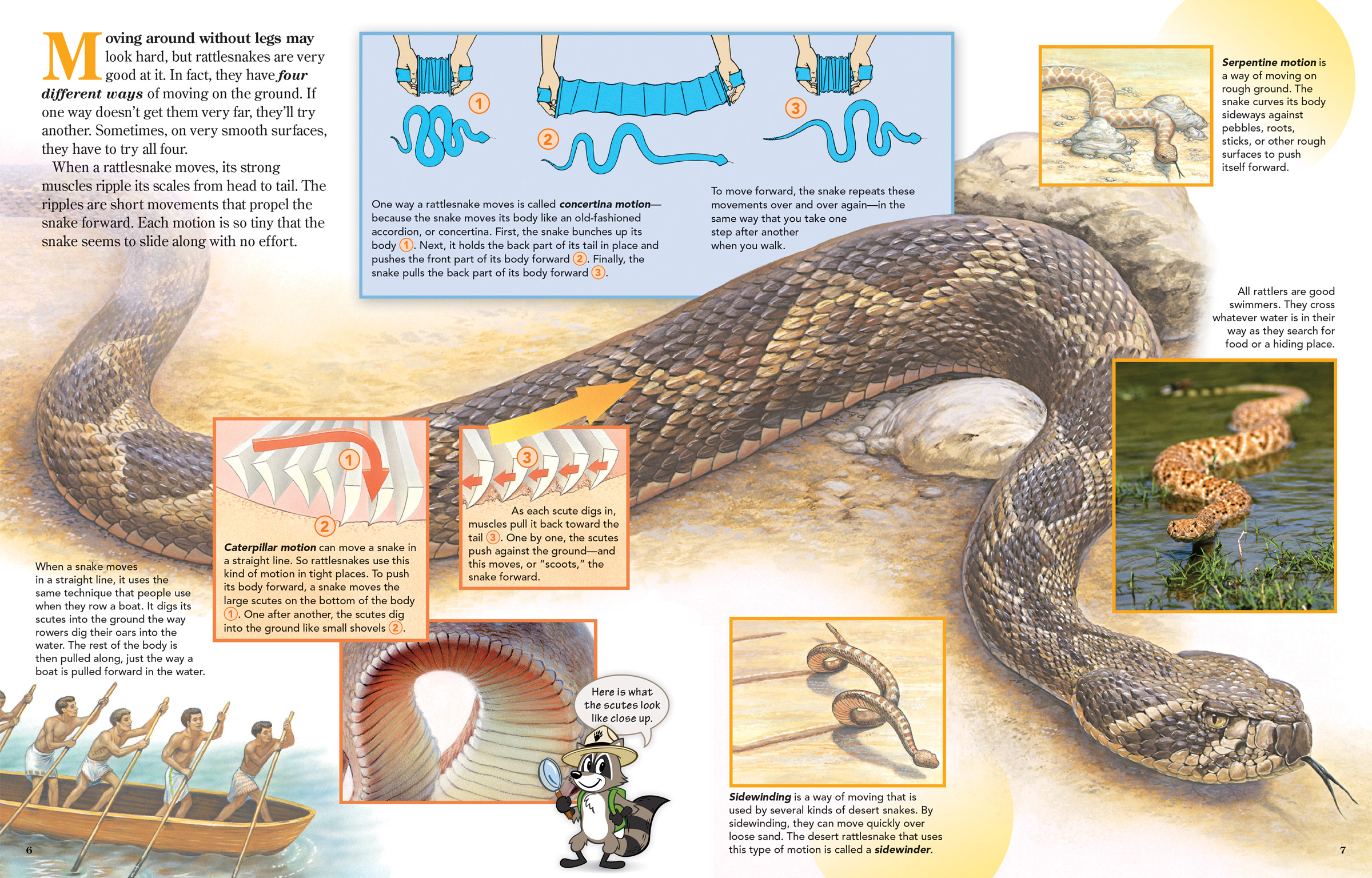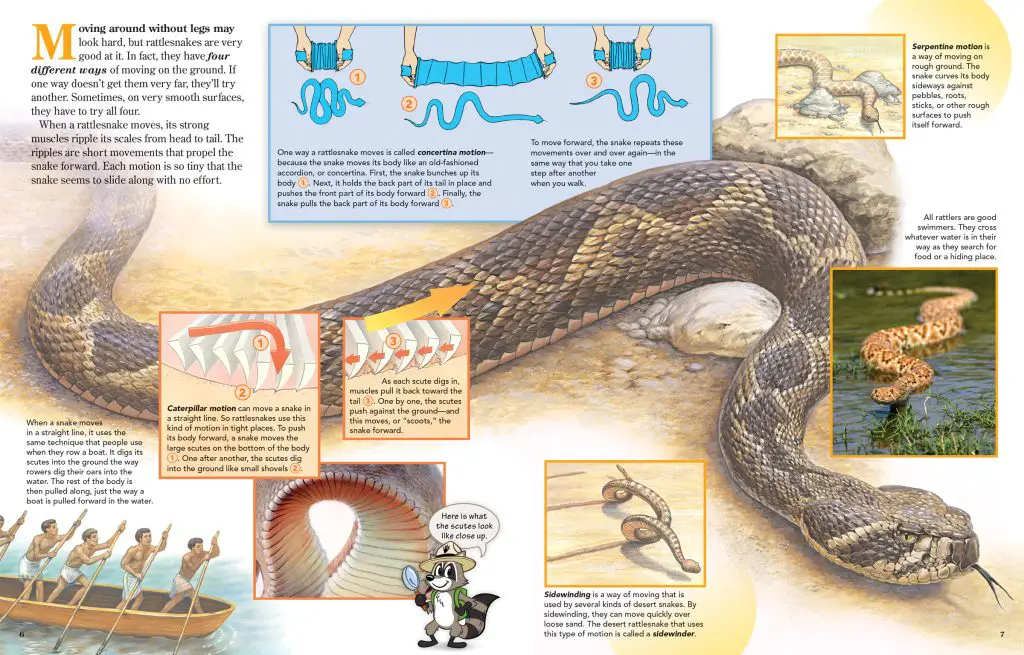Rattlesnakes are fascinating creatures that have long intrigued scientists and nature enthusiasts alike. Their unique ability to move with such grace and precision has captured the attention of many. But have you ever wondered how these slithering serpents actually move?
Rattlesnakes use a combination of muscular contractions and body waves to propel themselves forward. This allows them to move quickly and efficiently, even over rough terrain. In this article, we will explore the various methods used by rattlesnakes to move and the adaptations that make them such efficient hunters.
Rattlesnakes move by slithering on their bellies, using their strong muscles to push and pull themselves forward. They can move quickly, up to 8 miles per hour, and use their tails to maintain balance and steer. Rattlesnakes are also capable climbers and swimmers.

How Do Rattlesnakes Move?
Rattlesnakes are known for their distinctive rattling sound and venomous bite, but have you ever wondered how they move? These fascinating creatures have a unique way of getting around, which is the result of their specialized anatomy and behavior. In this article, we’ll explore the different ways that rattlesnakes move and what makes them so efficient at navigating their environment.
Slithering
When most people think of how snakes move, they probably imagine them slithering along the ground. This is indeed the most common mode of transportation for rattlesnakes, as well as many other types of snakes. The movement is achieved by the snake contracting and relaxing its muscles in a wave-like motion, which propels it forward. Rattlesnakes have specially adapted scales on their undersides, which grip the ground and provide traction as they move.
Slithering is an incredibly efficient way for snakes to get around, as it requires very little energy expenditure. However, it does have its drawbacks. For one, it’s not very fast – most snakes can only slither at a rate of a few miles per hour. Additionally, it can make them more vulnerable to predators, as they’re more exposed when they’re on the ground.
Sidewinding
Another method of movement that rattlesnakes use is called sidewinding. This is a specialized way of moving that allows them to traverse sandy or loose terrain more easily. Instead of moving in a straight line, the snake lifts its body up and moves it forward in a series of S-shaped curves. This allows it to maintain traction on the ground while also conserving energy.
Sidewinding is an incredibly impressive sight to witness, as it looks like the snake is almost floating above the ground. However, it’s also a very slow way of moving and is generally only used when the ground conditions require it.
Benefits of Rattlesnake Movement
Rattlesnakes have evolved to move in a way that maximizes their efficiency and allows them to navigate a variety of environments. Slithering is a great way to conserve energy while still covering a lot of ground, while sidewinding is ideal for difficult terrain. By having these different modes of movement at their disposal, rattlesnakes are able to adapt to their surroundings and avoid potential threats.
Rattlesnake Movement Vs. Other Snakes
While all snakes move in a similar way, rattlesnakes have some unique adaptations that set them apart. For example, their specialized scales and muscular anatomy allow them to move more efficiently and with greater precision than many other types of snakes. Additionally, their rattles serve as a warning to potential predators, which can help them avoid dangerous situations.
Overall, the way that rattlesnakes move is a testament to their resilience and adaptability. By understanding how they navigate their environment, we can gain a deeper appreciation for these fascinating creatures and the important role they play in their ecosystems.
Frequently Asked Questions
Do rattlesnakes have legs?
No, rattlesnakes do not have legs. Instead, they have a long, slender body that allows them to move quickly and efficiently. They use their muscles to slither along the ground, and can move at speeds of up to 8 miles per hour. While they do not have legs, they do have scales on the underside of their body that help them grip the ground and move forward.
Rattlesnakes are also able to climb trees and swim in water thanks to their unique body shape. They can use their muscles to climb up tree trunks and branches, and can even swim across bodies of water using their body as a paddle.
How do rattlesnakes move without legs?
Rattlesnakes use a method of movement called serpentine locomotion. This involves moving the body in a series of S-shaped curves, which allows the snake to push off against the ground and move forward. By alternating the direction of their curves, they are able to move in a straight line.
The muscles in a rattlesnake’s body also help with movement. They use their muscles to contract and expand their body, which allows them to slither along the ground. Their scales also play a role in movement, as they help the snake grip the ground and move forward with greater ease.
How fast can rattlesnakes move?
Rattlesnakes are capable of moving at speeds of up to 8 miles per hour. However, they typically move much slower than this, as they are often hunting for prey or trying to avoid predators. When they do move quickly, it is usually in short bursts to escape danger or catch prey.
The speed at which a rattlesnake moves can also depend on the surface they are moving on. They are faster on smooth, flat surfaces like concrete or pavement, and slower on rough, uneven terrain like dirt or rocks.
Can rattlesnakes climb?
Yes, rattlesnakes are capable of climbing trees and other structures. They use their muscles and scales to grip onto surfaces and climb upwards. While they are not as efficient at climbing as animals with limbs, they are still able to scale vertical surfaces with relative ease.
Rattlesnakes are also able to swim, which allows them to move across bodies of water or navigate through wet environments.
How do rattlesnakes move when they are hunting?
When hunting, rattlesnakes use their sense of smell to locate prey. They then use their muscles to move stealthily towards the prey, often in a serpentine pattern to avoid detection.
Once they are close enough to the prey, they strike with their venomous fangs and subdue the animal. They then use their muscles to coil around the prey and constrict it, squeezing it to death before swallowing it whole. Rattlesnakes are skilled hunters and are able to take down prey much larger than themselves.
How do Rattlesnake Rattles Make Sound?
In conclusion, rattlesnakes have a unique way of moving that sets them apart from other snake species. Their distinctive movement is characterized by the lateral undulation of their bodies, which they use to propel themselves forward. This movement is achieved by contracting their muscles on one side of their body while stretching them on the other.
Rattlesnakes use their tails as a tool to help them move. Their tails are made up of interlocking segments that can produce a rattling sound when shaken. This sound is an effective warning to potential predators or prey that the snake is present. It also helps the snake to navigate through its environment by sensing vibrations in the ground.
Overall, the movement of rattlesnakes is a fascinating subject that has captured the interest of scientists and nature enthusiasts alike. By understanding how these snakes move, we can appreciate their unique adaptations and the important role they play in their ecosystems.


